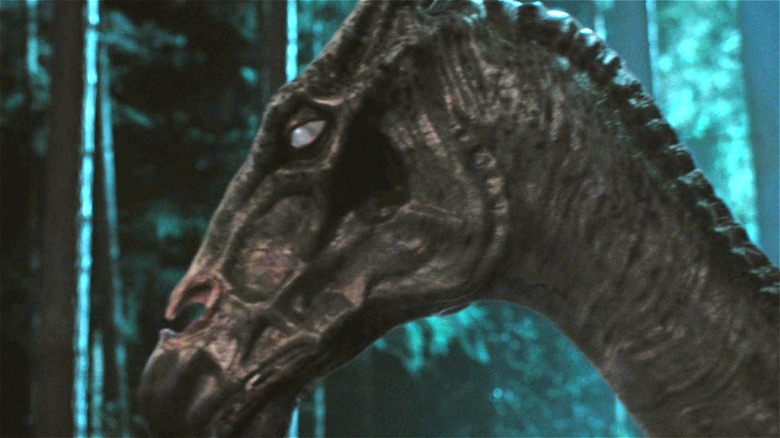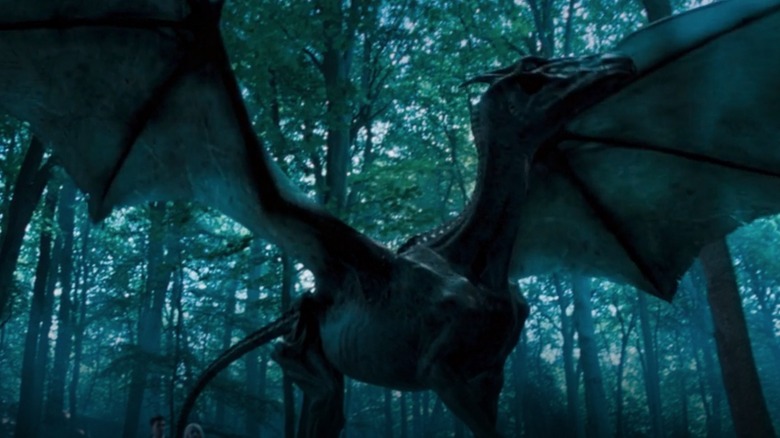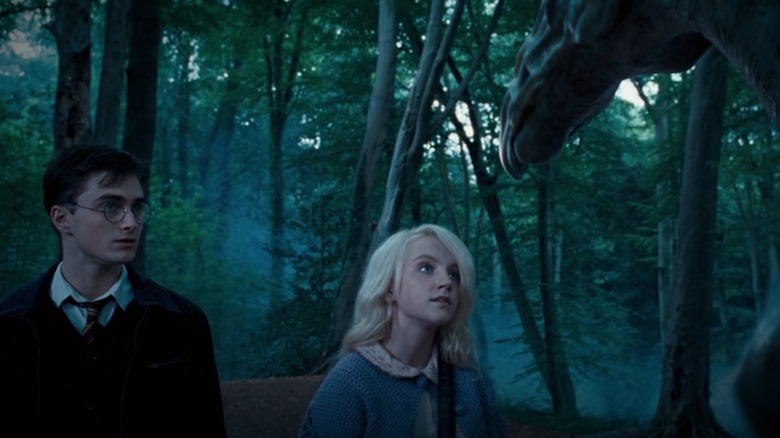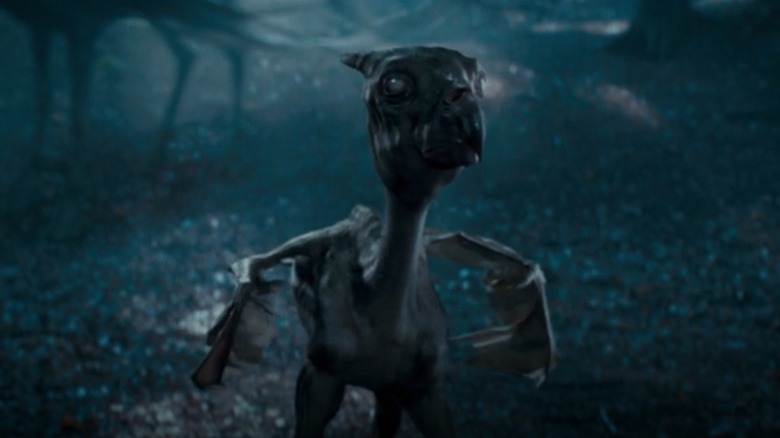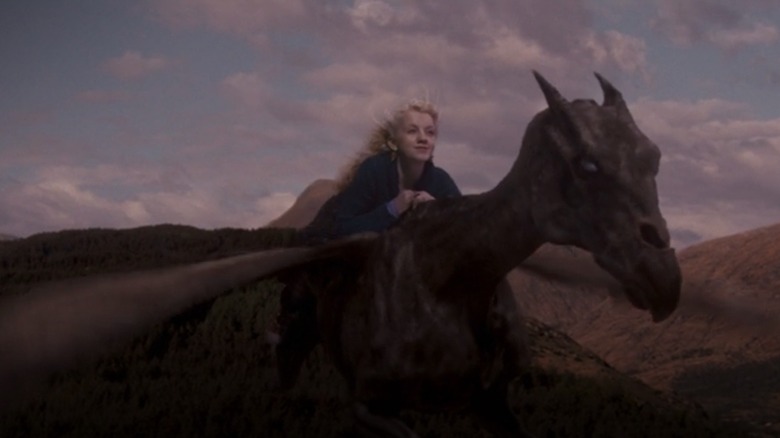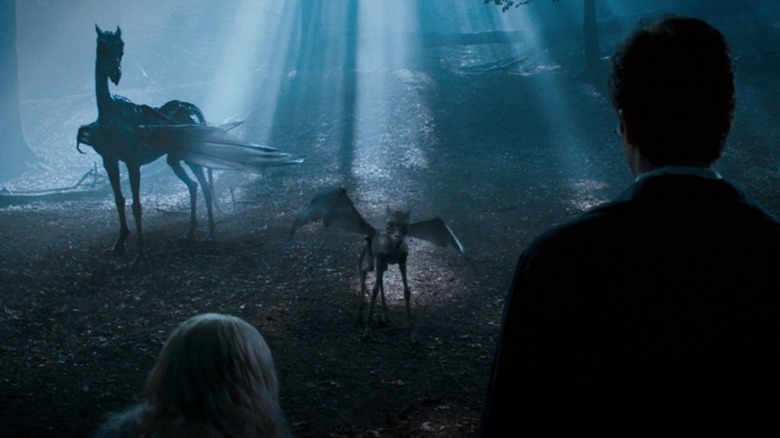The Thestrals In Harry Potter Explained
The end of Harry Potter's (Daniel Radcliffe) fourth year of school marks a sharp turn in the series' tone: fellow student Cedric Diggory (Robert Pattinson) is dead, Lord Voldemort (Ralph Fiennes) has risen, and the Wizarding World feels darker and more dangerous than the unabashed wonder of Harry's first foray into magic. Up to this point, we've seen an array of magical creatures, from fire-breathing dragons to giant, three-headed dogs, but it's not until things get truly serious that we meet the thestrals.
We first see thestrals when Harry first sees them: It's the beginning of his fifth year at Hogwarts, he's just gotten off the train with his friends and comes face to face with a creepy horse-like creature that only he can see. There are several of them, pulling the "horseless" carriages from the train station to Hogwarts. It's not all in his head, though, as Luna Lovegood (Evanna Lynch), the quirky Ravenclaw girl he's just met, can see them as well.
Of course, Harry's got plenty of more pressing issues to concern him — schoolwork, the insane new Defense Against the Dark Arts professor, no one believing him about the return of Voldemort — so it's only later in the year that we actually learn anything about these strange creatures. Here's everything you need to know about thestrals in the Wizarding World.
Thestrals are menacing, misunderstood figures
Thestrals are certainly unlike any real horse: They're far thinner than would seem healthy, with a black pelt stretched tight over their bones, giving them a skeletal appearance. Then there are their large wings that resemble a giant bat, protruding out of either side of the thestral's back. However, while their bodies resemble horses — save the wings — their heads are more dragon-like. In the books, the head is described as reptilian, with fangs, empty white eyes, and black manes. The movies change this up a bit, giving their heads features more akin to a bird's beak.
According to the official Wizarding World website (which features an explanation written by author J.K. Rowling for the defunct website Pottermore back in 2015) thestrals are native to the United Kingdom, but also live in parts of France, Spain, and Portugal; other places in the world have magical species that are different, but similar to thestrals. As for their habitat, we know that the herd at Hogwarts prefers the darkest parts of the Forbidden Forest. Plus, to make them even weirder, they're carnivorous and will eat animals like birds — though Hagrid trained the Hogwarts herd not to go after the many owls delivering mail around the school. In "The Order of the Phoenix," Harry discovered they're also attracted to blood when several of them came to lick it off his sleeve.
To create the thestrals for the movies, the animators referenced mostly horses, birds, and bats, but also looked at footage of vultures, lions, and hyenas to depict a baby thestral tearing into a piece of meat. In a behind-the-scenes featurette, VFX Animation Supervisor Steve Rawlins explained that director David Yates added in the scene with Luna feeding the baby thestral to illustrate that, despite their undead appearance, thestrals are living creatures.
Thestrals can only be seen by people touched by death
The reason Harry never saw the skeletal horses pulling Hogwarts' carriages until his fifth year is that to see them, a person has to have watched someone die and "gained an emotional understanding of what death means," according to Rowling (via Wizarding World). So, despite witnessing his mother's death as a baby and riding in the carriage shortly after watching Cedric die, it isn't until he returns to Hogwarts that he actually has a deeper understanding of death. When he was a baby, "he had been unable to comprehend his own loss." As for Cedric: "Weeks elapsed before the full import of death's finality was borne upon him."
In the book "Order of the Phoenix," Hagrid takes the fifth-year class of Care of Magical Creatures to see the thestrals. He puts a cow carcass down and shrieks to attract their attention, but most of the class just sees the cow being devoured by some invisible force. Among Harry's peers, at this point, only Luna and Neville can see the thestrals. The movie frames the forest thestral scene as a quiet bonding moment between Harry and Luna, rather than a class excursion. She says that at 9-years-old, she saw her mother die when she was experimenting with a spell and is, therefore, able to see the thestrals. Rowling explains it: "She is intuitive, spiritual and unafraid of the afterlife."
After the climactic Battle of Hogwarts at the end of "The Deathly Hallows," it's fair to assume most people who participated can now see the nightmarish creatures that have been ferrying them to and from the school.
The superstition is that they're unlucky
Between their ghastly appearance and unique, conditional invisibility, thestrals have long been misunderstood in the Wizarding World. Superstitious people believe they're unlucky and will bring misfortune to anyone who sees them. Over the years, they have been hunted and are classified as dangerous by the Ministry of Magic, despite their truly gentle nature. Thestrals aren't likely to hurt any humans unless they're provoked to do so — they can bite if they need to.
As for Harry Potter's story, the thestrals come in at a crucial moment: Harry feels terribly alone in his fifth year, as he's coping with the trauma of watching Cedric die. Few people believe him when he says Voldemort is back, but he's well aware of the looming threat. Amidst this, the thestrals become a physical representation of the pain, change, and growth he's going through, highlighting how his experience seeing Voldemort's return is a trauma his best friends can't relate to. Rather than bringing any misfortune to Harry, thestrals are merely a sign of the misfortune he's already experienced. In the Wizarding World article on thestrals, Rowling wrote that they "are emblematic of a journey to another dimension, and reward all who trust them with faithfulness and obedience."
Despite their poor reputation, thestrals prove useful to wizards
Thestrals are clever magical creatures with a great sense of direction, so the herd at Hogwarts has been put to use bringing carriages from Hogsmeade station to the school. Hagrid remarks that they are probably the only trained thestrals in Britain, but "Fantastic Beasts: The Crimes of Grindelwald" depicts an auror using them to pull his flying prisoner transport carriage. It looks like a goth take on Santa's sleigh that would perfectly suit Jack Skellington, if he tried another crack at Christmas.
Brave souls can mount a thestral and ride it, but it's not an easy thing to do. In the "Order of the Phoenix" book, Harry describes the experience of flying on a thestral as the fastest he's ever flown, apparently outpacing any of his brooms. Then there's the problem of seeing what you're riding. When Harry and a few of the other members of Dumbledore's Army ride thestrals to go save Sirius at the Ministry of Magic, half of them can't even see the creature beneath their legs as they zip through the sky.
Still, they come in handy again in "The Deathly Hallows," when Harry and members of the Order of the Phoenix can't use spells to transport Harry for fear of being detected. To throw off Voldemort and his Death Eaters, they have Harry and six decoy Harrys flying out on brooms, thestrals, and in Hagrid's sidecar. In the book, the Hogwarts herd helps in the Battle of Hogwarts, attacking Voldemort's giants. Evidently, they're unlucky just for Voldemort, which makes perfect sense considering his fear of death and inability to accept its inevitability.
The Elder Wand has a thestral hair core
Thestrals, it turns out, are even more important in "Harry Potter" than many fans realize: At the core of the Elder Wand, one of the three Deathly Hallows and the most powerful wand in the world, is the hair of a thestral. Every wand has some piece of a magical creature at its core — a phoenix feather, a unicorn hair, and a dragon's heartstring are the most common — but thestral hair is far rarer. The wandmaker Ollivander doesn't work with the material, according to Wizarding World. Already, the elder wood that the Elder Wand is made out of is unusual, so the thestral hair only adds to its uniqueness — just don't think too hard about how the movie's thestrals don't appear to have any hair.
This detail is never stated in the books or movies, but Rowling wrote it on her old website, describing thestral hair as "a powerful and tricky substance that can be mastered only by a witch or wizard capable of facing death." Its connection to the Elder Wand makes sense, as the Deathly Hallows are intimately linked with death. As the story goes, Death is the one who created them, so to hold all three is to master death. Some fans theorize that the other two Deathly Hallows were also made with materials from thestrals, especially considering thestrals have invisibility magic and one of the Hallows is Harry's Cloak of Invisibility — perhaps it was woven with their hair or created from a pelt.
Even amongst the various magical creatures in the world of "Harry Potter," thestrals stand out as one of the most intriguing. These fantastic beasts, though, are indeed awfully hard to find.
